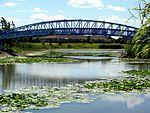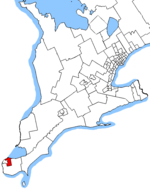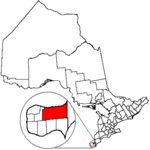Peche Island (French pronunciation anglicized to , therefore occasionally misspelled "Peach"), is an uninhabited, currently 86-acre (35 ha) (reduced by erosion from a 1965 measurement of 109 acres / 43.7 ha) Canadian-owned island in the Detroit River, at its opening into Lake Saint Clair. It is 1.2 miles (1.9 km) east of U.S.-owned Belle Isle, and 360 yards (330 m) from the Windsor shore.
The island was formed from a peninsula of the Canadian shore by the action of the Detroit River. There is a central marsh on the island. The present channel was eroded until the core of the island remained. There are man-made channels cut through the island to ensure fresh water supply and recreational opportunities. The island's flora and fauna have been heavily affected by human activity, and the forest is the result of a rehabilitation programme.
Formerly an Ontario provincial park, ownership was transferred to the City of Windsor in 1999. The Detroit River passes 200 yards (183 m) off its northern shore and daily 1,000-foot-long (300 m) ships pass.
The island offers attractive Detroit city views, a wide sandy beach and shallow river bottom, and is a favorite with summer boaters. As of June 27, 2018, the City of Windsor began to run a ferry service to the island for day trips. Tours operate on select days during the week and weekends, weather permitting, from June to October. Boaters, canoers and kayakers can enjoy the island's trails and beaches and approximately 2.5 miles (4 km) of canals. The park is open only during the day. Sailors are advised to anchor along the southern shore of the island, abeam the Windsor Yacht Club. Speed between red buoy DP2 west of Peche Island and green buoy DP5 east of Peche Island must be held below 5 knots (9 km/h). For kayakers, the circumnavigation distance is approximately 3 miles (4.8 km).
From November through March large numbers of waterfowl, especially canvasback, redhead, lesser scaup, common goldeneye and common merganser, are all found in the nearby waters. Peregrine falcons and bald eagles are often attracted by these large flocks and can sometimes be seen perched in the island's larger treetops, or in the nesting platforms constructed by the Essex County Field Naturalists' Club. Muskie, walleye, bass, bluegill and perch are found in the waters surrounding the island, and fishing pressures are reported low. Water quality is good, and carefully monitored, as the City of Windsor's supply is drawn from nearby. Peche Island is one of the few places where the rare blue ash tree (Fraxinus quadrangulata) can be found.







